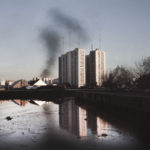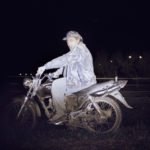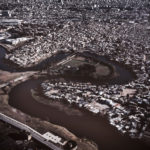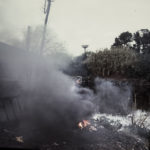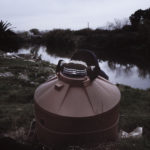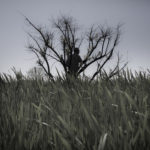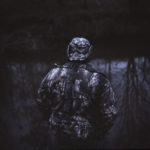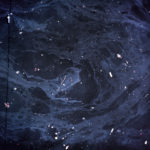- A building complex in Avellaneda, in the province of Buenos Aires, with a burning landfill behind.
- An aereal view of The Riachuelo, where the river divides Avellaneda, in the province, and the Villa 21-24, in Buenos Aires. This slum is the biggest in Buenos Aires with 60,000 inhabitants, and it has the highest concentration of people affected by the pollution of the river, with the higest rates of respiratory illnesses.
- A woman puts her head into a water tank to see if she can find any recyclable material to pick it up. This tank was brought two years ago with the goal of improve the sanitary conditions of the neighbors by the Riachuelo River, but it was never properly installed and it left there remaining as part of the landscape of the shore.
- Daniel Ramirez, a worker of a local cooperative, look out for a water mirror inside a wetland in a Natural Reserve in the Matanza-Riachuelo basin. The reserve is very important for the environment in this over polluted area, because it works as a sponge: it absorbs floods of different streamings of the zone. Last years, it has been a very disputed territory, with soil merchandising, waste disposal, use of agrochemicals and infrastructure plans, threatening the reserve.
- Maite and Bianca, twins, 5 years old, cross the Riachuelo River in a boat. They live in Isla Maciel and cross every day the river to Buenos Aires to go to the kindergarden.
- Oscar Vique observes the river where the river begins. More than 60 km away from the city, the Matanza River (it changes the name into Riachuelo when it enters the city, the last part) starts the route much less poisoned and in a wilder and safer environment. «We come here with my wife and kids every summer to drink mate and enjoy the pace of the river». He lives 300 meters away from the river in a small village of 200 inhabitants, near Marcos Paz, Buenos Aires Province.
- A view of the Riachuelo River and its garbage.
Nacido en Buenos Aires, habité la ciudad toda mi vida. El Riachuelo bordea el sur de la metrópoli, es el límite que la separa de la provincia. Para mi generación el río ha sido un sinónimo de contaminación y abandono de los recursos naturales.
La traza del Matanza-Riachuelo recorre unos 64 kilómetros y en su cuenca viven más de 5 millones de habitantes. En su caudal se acumulan cantidades extraordinarias de residuos industriales y cloacales, lo que lo convierte en uno de los más contaminados del mundo. A pesar de los esfuerzos para limpiar el agua y controlar a las empresas contaminantes, se calcula que más de 13 mil fábricas continúan vertiendo allí sus deshechos, provocando graves enfermedades a los pobladores de sus márgenes.
El proyecto explora a través de distintas plataformas el ecosistema humano y natural de la cuenca Matanza-Riachuelo. Entrando a las vidas de las personas que se encuentran en mayor proximidad con el río y expuestas diariamente a su contaminación, las imágenes abordan la complejidad de los conflictos que coexisten en la cotidianidad de este territorio repleto de tensiones y contradicciones. Fotografías, videos, sonidos, testimonios y mapas interactivos son parte de este proyecto transmedia.


